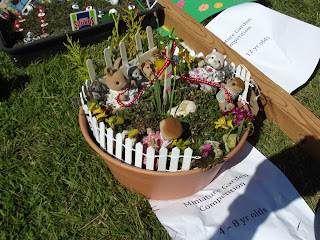 |
| Afternoon tea for two |
This week's blog looks at the traditional tiffin- three dainty courses, but served elegantly on the lawn or in the parlour.
A traditional afternoon tea has three elements: the savoury course (made up of dainty sandwiches and small savoury treats), the sweet course ( tiny cakes and meringues) and the cream tea (scones, with cream, and jam or fruit and a pot of tea.)
My version features smoked salmon sandwiches along with cucumber and dill squares and cakes aux olives for the savoury course. Followed by a trio of fairy cakes - a mini Victoria sponge, a butterfly cake and an iced fairy cake- along with meringues with fruit and cream. Plus of course the scones!
 |
| Sandwiches, cakes and meringues |
The sandwiches should have the crusts removed and the bread cut into shapes (triangles and squares for example). The cucumber and dill filling is delightful- spread the bread with herby cream cheese into which you have mixed some chopped dill, then add layers of peeled and finely sliced cucumber.
Don't waste those crusts though- I cut mine into cubes and froze them in a container to use as croutons in salads and soups.
 |
| Future croutons! |
The olive cakes have featured before on the blog- but it is my most popular recipe -so no apologies for featuring it again.
Ingredients- 160g of olives, 100g of self raising flour, 1 tsp baking powder, 3 eggs, 1 pot natural yoghurt or 100 ml of skimmed milk, 80 ml of olive oil and 100g of grated cheese.
Roughly chop the olives, beat the eggs into the milk and then combine all the ingredients in a large mixing jug. Pour into silicone muffin moulds and bake at 200 degrees for 15-20 minutes until firm and golden.
 |
| Cakes aux olives |
For the fairy cakes- make up a plain cake batter using 125g of self raising flour, 125g of butter and 125g of caster sugar, 1 tsp of vanilla essence and 2 beaten eggs.Pour into paper cases and bake at 200 degrees for 15 minutes until lightly golden.
When cool, split some of the cakes in two and spread with jam and cream, sandwich back together and sprinkle with icing sugar ( to make mini Victoria sponges ), slice the tops off others, fill with cream and then replace the top cut into two 'wings' to make butterfly cakes. Ice the remainder with toppings of your choice- cream and fruit, icing and sprinkles, buttercream icing etc
The meringues are simplicity itself (if you buy shop meringue nests). Just top with creme fraiche and berries.
Scones are next. I always follow a recipe from my mum's old school cookery book circa 1946!
The ratio of ingredients should be 1/8 fat to flour, 1/8 sugar, 1/8 other ingredient eg. fruit
So for 250g of flour and 2 tsp of baking powder, rub in 60-70g of margarine, add same quantity of fruit and sugar and mix to a stiff dough with approximately 100 ml of milk.
Turn out onto a floured board and shape into a round about 4cm thick.
Use cutters to shape your scones or cut into triangles (for savoury scones).
Place them on a greased baking tray, brush with milk and place in a hot oven (210 degrees) for 4 minutes and then reduce the heat to 190 degrees and cook for a further 10-15 minutes until golden.
Scones can be varied endlessly- why not try mixing in fresh fruit such as rhubarb :
 |
| Rhubarb scones |
Or cheese, olives, pepper or spring onion for savoury scones:
 |
| Cheese scones |
But what of the leftovers? Well, cucumber is very good cooked. I made a cucumber and scallion soup- which was tasty warm (but would do nicely chilled in shot glasses as part of a buffet). Just peel and slice the remaining cucumber,slice some spring onions and add them all to some vegetable stock. simmer for 20 minutes or so, then blitz with a little skimmed milk. Season to taste and decorate with chopped herbs.
Olive cakes freeze really well, and I often have one or two with a salad as part of my packed lunch.
So there you have it: afternoon tea for two and a few extra meals besides.
I will leave you with some images of the church
fete so you can conjure up the right ambiance!
A quintessentially British summer event! (With tea and cakes.)



No comments:
Post a Comment